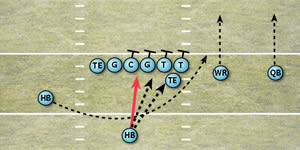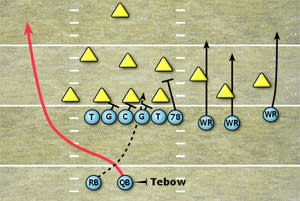Broncos follow trend to maximize Tebow's ability
The Denver Broncos may have looked as if they invented the NFL version of the read-option offense last Sunday against the Oakland Raiders, but what head coach John Fox, offensive coordinator Mike McCoy, and the rest of the team's coaching staff installed to get the most out of quarterback Tim Tebow's(notes) abilities was actually one more point in a narrative line. That timeline now goes back a few years as more coaches and teams look to bring collegiate offensive concepts to the pros to maximize specific personnel issues. More specifically, the option offense is one way to answer the question: How do you win in the NFL if you don't have a truly elite passer on your squad?
The Vick Option
Starting in 2004, the Atlanta Falcons answered that question with different iterations of option football. The Falcons were transitioning from Dan Reeves to Jim Mora, and brought offensive line guru Alex Gibbs on staff. Gibbs made his name guiding a series of dominant zone-blocking teams in Denver, and his blocking concepts made Atlanta's option ideas nearly unstoppable.

Figure 1
The Falcons used many different versions, but the overall concept was the same: get the line zone-blocking away from the play side to influence the front seven, and have Michael Vick(notes) roll right to get the left defensive end on a string (Fig. 1). The difficulty any defender had in picking up the option was that Vick could either read the end pursuing outside and pull the ball in, or catch the end pinching inside and pitch it out to the back. Between Vick and running backs T.J. Duckett(notes) and Warrick Dunn(notes), it became quite the challenge to figure out what the Falcons were doing on any given play.
In the Falcons' version of the option offense, Vick's unreal athleticism made all the difference – they'd also run a version of the quarterback draw in which Vick would drop back, stop at the dropback point, wait, and hit the first seam he saw at maximum speed. He wasn't taken seriously as a passer the way he is now; he was more a superhuman version of the straight option quarterbacks you'd so often see dominate the NCAA and wash out in the NFL. Vick didn't become a more skilled pocket passer until his time with the Philadelphia Eagles, and over time, the risk of getting Vick hurt as a running quarterback became a paramount issue. That risk/reward option became another problem to solve, and an unexpected team would solve it in short order.
The Wildcat
On a flight back to Miami after a 31-10 defeat to the Arizona Cardinals in Week 2 of the 2008 season, new Dolphins head coach Tony Sparano was given a great schematic gift by quarterbacks coach David Lee. The previous year, Lee was the offensive coordinator at Arkansas, and he told Sparano about a "Wild Hog" series of plays he thought might work with the Dolphins' current personnel. At 0-2 and without much to lose, Sparano green-lighted three different plays that Lee had run with the amazing backfield of Darren McFadden(notes) and Felix Jones(notes).
Inserting Ronnie Brown(notes) into McFadden's old role as the man taking the snap from center and Ricky Williams(notes) as the "sweeper" as Jones had been, Lee and the Dolphins were about to shock a team that was carrying a 21-game regular-season winning streak. When the Dolphins faced the New England Patriots in Foxboro in Week 3, the "Steeler," "Power," and "Counter plays were wildly successful. Miami ran for 216 yards and Brown accounted for five touchdowns (four rushing, one passing) as the Dolphins demolished Bill Belichick's vaunted defense.

Figure 2
The three plays challenged defenses in different ways. The Steeler sweep (Fig.2) had the sweeper cruising through the backfield and getting yardage based on the line's zone-blocking and unbalanced look (two right tackles and no left tackle), and the fake from the halfback drawing the defense in. The quarterback was on the field for all three types of plays, but he was an ancillary figure on the outside. The idea was to eliminate the quarterback from the set play and force a defense to deal with one more athletic and powerful runner.

Figure 3
The Power play was far more based on the inside run and pull-blocking. In this play (Fig. 3), the sweeper runs through the backfield and takes a fake pitch from the halfback, who then blasts upfield through any gaps presented by the line's blocking, the left guard pulling, and the sweeper's ability to take on an extra defender. Unlike the Vick options, the Wildcat sets were about putting a man on a man and winning the power battle.

Figure 4
The Counter play (Fig. 4) was perhaps the most interesting, and the closest to what you saw Tebow do with the Broncos last Sunday. On this play, the sweeper takes a fake pitch and squares to block, but the left guard doesn't pull – he stays home to man-block and make up for the loss of the tight end, who will run a seam route. If the defense is influenced by the blocking and fake sweep, there should be a huge gap to the left side of the field. The halfback could either run or throw a pass to the tight end, and the Dolphins did both of those things in 2008.
Later in the season, the Dolphins also fooled the Houston Texans for a long touchdown pass to running back Patrick Cobbs(notes) when Brown pitched to Williams, who then gave the ball to quarterback Chad Pennington(notes) to the right side. The Texans defense was so confused, Cobbs was open by about 15 yards.
The Titans' Triple Option

Figure 5
The Wildcat didn't catch on as much as some expected – the NFL has become more and more a passing league – but in 2009, the Tennessee Titans were the next team to find a college option concept and use it to their advantage based on a prior embarrassment. After losing to the Patriots 59-0 in a Week 6 disaster, head coach Jeff Fisher and offensive coordinator Mike Heimerdinger decided to re-install Vince Young(notes) as their starting quarterback, and move their offense from typical sub-effective NFL to triple option.
Not only did the new offense play to Young's strengths as a runner and option passer from his days at Texas, but the threat of Young as a runner did even more for running back Chris Johnson than Vick had done for Dunn and Duckett in Atlanta. Johnson finished that season as the last of six men in NFL history to rush for more than 2,000 yards in a single season.
However, it wasn't just the run that defenses had to fear with Tennessee's triple option – the Texans were rocked to sleep by a particularly devastating passing concept (Fig. 5) in Week 10 of that season. This one's a beauty.
Receiver Nate Washington(notes) (No. 85) ran an end-around, and with the offensive line sliding left (we see over and over how much influence blocking is key to successful option plays), the defense started to bite that way. The motion cleared left cornerback Glover Quin(notes) out through the middle and safety Bernard Pollard(notes) came up into the box. Left end Mario Williams(notes) was busy chasing Young as he rolled out of the pocket, but Young was more interested in the crossing over route run by receiver Kenny Britt(notes) (18), who was just ahead of cornerback Dunta Robinson(notes) (23). It was pitch-and-catch for Young and Britt because the rollout, swing pass threat, and potential end-around cleared out Houston's intermediate coverage and left the play up to Britt's speed.
As the game and the season progressed, opposing defenses became as affected by the very thought of the option as by the option itself, and Young would find free lanes as defenses bit on various counters and motion sets after the snap.
The Tebow Zone Read

Figure 6
The Raiders got some grief for falling prey to the Broncos' read-option concepts, but what Denver put on the field was a bit more complex than people imagined, and Tebow is a supreme rushing threat, especially for a quarterback – he's built more like Peyton Hillis(notes) than Peyton Manning(notes), and he had as many rushing touchdowns (57) in college as Marshall Faulk. The Broncos did a few different things to take advantage of Oakland's awareness of Tebow's running prowess, but the staple play (Fig. 7) was a variant of the counter play we saw in the Wildcat formation.
The difference here is that everything the Broncos were doing from a formation perspective sells the defense away from play side – the line was sliding to the right, there was an extra right tackle (Ryan Clady(notes), No. 78, Denver's best blocker), and the trips right formation took the secondary from straight man coverage to a single-high safety concept with man underneath to one side. At the snap, the defensive line – especially end Jarvis Moss(notes) – was influenced to the defensive left along with the blocking. The three receivers to the right ran vertical routes of varying lengths, taking three more defenders out of the picture. And when Tebow faked a handoff to halfback Willis McGahee(notes) (23), all three linebackers took the bait and rolled inside.
Thus, Tebow had a huge gap to the left, which he used to rush for one of many long gains.
The Broncos rushed for 299 yards in their 38-24 win, Tebow and McGahee each amassed more than 100 yards on the ground, and the vast majority of those came on option read plays. "As long as it worked, that's all I care about," McGahee said after the game. "[Tebow] did a great job as far as reading the ends on what he had to do as far as keeping it or giving it. When I got the ball, it was my job just to get some yards."
It will be McGahee's job to do that again when the Broncos face the Kansas City Chiefs on Sunday. You can expect to see Tebow at the head of the zone read until some defense forces Denver to ditch the strategy. But in the meantime, don't labor under the impression that the Broncos are bringing something new to the NFL – for almost a decade, different teams have been building better mousetraps with what used to be exclusively college formations.
Other popular stories on Yahoo! Sports:
• NBA players to consider owners' new offer
• Dana White too frazzled to enjoy UFC's ride
• What's Adrian Peterson doing with his millions?
• Penn State scandal puts football into proper context
